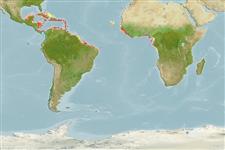Common names from other countries
>
Ovalentaria/misc (Various families in series Ovalentaria) >
Pomacentridae (Damselfishes) > Glyphisodontinae
Etymology: Abudefduf: Arabic, abu = father; this fish is the leader of the reef against other species (Ref. 45335).
More on authors: Müller & Troschel.
Environment: milieu / climate zone / depth range / distribution range
Ecologia
marinhas associadas(os) a recifes; não migratória; intervalo de profundidade 1 - 5 m (Ref. 9710). Subtropical; 24°N - 7°S, 133°W - 62°E (Ref. 56030)
Western Atlantic: southern Florida, USA and the Caribbean Sea. Reported from northern South America (Ref. 5217). Eastern Atlantic: Cape Verde and from Senegal to Angola.
Tamanho / Peso / Idade
Maturity: Lm ? range ? - ? cm
Max length : 25.0 cm TL macho/indeterminado; (Ref. 7251); common length : 20.0 cm SL macho/indeterminado; (Ref. 3139)
Descrição breve
Chaves de identificação | Morfologia | Morfometria
Espinhos dorsais (total) : 13; Raios dorsais moles (total) : 11 - 12; Espinhos anais: 2; Raios anais moles: 10. Caudal fin lobe rounded (Ref. 7247). A heavy-bodied, compressed species; tawny yellow above, paler below, with 5 or 6 dark bars wider than interspaces between them (Ref. 26938). A sixth faint bar or dark saddle-like mark may be present on upper part of caudal peduncle; a prominent black spot at upper base of pectoral fin (Ref. 13442).
Adults inhabit rocky inshore reefs. They prefer wave-cut rock ledges or limestone shorelines and tide pools in regions with surf. Feed mainly on algae but adults also consume Zoanthus and hydroids while juveniles also feed on copepods (Ref. 9626). Oviparous, distinct pairing during breeding (Ref. 205). Eggs are demersal and adhere to the substrate (Ref. 205). Males guard and aerate the eggs (Ref. 205). Marketed fresh (Ref. 3139).
Life cycle and mating behavior
Maturities | Reprodução | Spawnings | Egg(s) | Fecundities | Larvas
Oviparous, distinct pairing during breeding (Ref. 205). Eggs are demersal and adhere to the substrate (Ref. 205). Males guard and aerate the eggs (Ref. 205).
Allen, G.R., 1991. Damselfishes of the world. Mergus Publishers, Melle, Germany. 271 p. (Ref. 7247)
Categoria na Lista Vermelha da IUCN (Ref. 130435)
CITES (Ref. 128078)
Not Evaluated
Ameaça para o homem
Harmless
Utilização humana
Pescarias: pouco comercial
Ferramentas
Relatórios especiais
Descarregue XML
Fontes da internet
Estimates based on models
Preferred temperature (Ref.
115969): 26.3 - 28.2, mean 27.5 (based on 581 cells).
Phylogenetic diversity index (Ref.
82804): PD
50 = 0.5000 [Uniqueness, from 0.5 = low to 2.0 = high].
Bayesian length-weight: a=0.02188 (0.00932 - 0.05134), b=3.08 (2.89 - 3.27), in cm Total Length, based on LWR estimates for this Genus-body shape (Ref.
93245).
Nível Trófico (Ref.
69278): 2.1 ±0.1 se; based on diet studies.
Resiliência (Ref.
120179): Médio, tempo mínimo de duplicação da população 1,4 - 4,4 anos (Preliminary K or Fecundity.).
Fishing Vulnerability (Ref.
59153): Low vulnerability (15 of 100).
